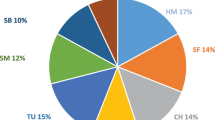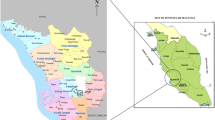Abstract
Methylmercury (MeHg) is a bioaccumulable toxin in the trophic chain and a powerful neurotoxin during fetal and child development. Consumption of contaminated fish and shellfish is a principal environmental source of MeHg exposure. This study was designed to assess the Hg and estimated MeHg intake in vulnerable groups of the Murcia region, a Mediterranean part of Spain, compared with international regulations. A validated food frequency questionnaire was used to assess seafood consumptions in 320 children younger than 10 years, 301 women of childbearing age, and 537 pregnant women. Hg concentrations were measured in the most consumed fish products by cold vapor generation–atomic fluorescence spectrometry. The weekly intake of MeHg (μg/kg bw/week) was 2.60 (95% CI = 2.10–3.10) in children 1–5 years, 2.65 (95% CI = 2.26–3.03) in children 6–10 years, 0.98 (95% CI = 0.89–1.07) in women of childbearing age, and 0.88 (95% CI = 0.81–0.95) in pregnant women. The main exposure to MeHg, especially in young children, is related to intake of bluefin tuna and swordfish. Fifty-four percent of children aged 1–10 years, 10% of pregnant women, and 15% of women of childbearing age exceed the Joint Expert Committee on Food Additives provisional tolerable weekly intake of MeHg. In the Murcia region, where fish is a central component of the diet, the focus should be on educating vulnerable populations to reorient fish consumption in order to lower the amount of Hg incorporated with the diet as well as to reduce Hg emissions into the environment.

Similar content being viewed by others

References
Agency for Toxic Substances Disease Registry (ATSDR) (1997) Toxicological profile for methyl Draft Update. ATSDP, Atlanta, GA
American Heart Association Nutrition Committee, Lichtenstein AH, Appel LJ et al (2006) Diet and lifestyle recommendations revision 2006: A scientific statement from the American Heart Association Nutrition Committee. Circulation 114:82–96, doi:10.1161/CIRCULATIONAHA.106.176158
Bloom NS (1992) On the methylmercury content of fish tissue. Can J Fish Aquat Sci 49:1010–1017, doi:10.1139/f92-113
European Commission (2004) Health & Consumer Protection Directorate-General. Methylmercury in fish and fishery products. Brussels, 12 May 2004. http://ec.europa.eu/food/food/chemicalsafety/contaminants/information_note_mercury-fish_12-05-04.pdf. Accessed 15 Jun 2008
European Commission (2006) Commission Regulation (EC) No. 1881/2006 of 19 December 2006 amending Regulation (EC) No. 466/2001 setting maximum levels for certain contaminants in foodstuffs as regards heavy metals. http://www.health.gov.mt/fsc/fsc_euleg_files/RegEC1881_2006e.pdf Accessed 15 Jun 2008
European Food Safety Authority (2004) The 8th meeting of the Advisory Forum—6 April 2004 (http://www.efsa.europa.eu/en/advisory_forum/adv_meetings/369.html). Accessed 15 Jun 2008
Falcó G, Llobet JM, Bocio A et al (2006) Daily intake of arsenic, cadmium, mercury, and lead by consumption of edible marine species. J Agric Food Chem 54:6106–6112, doi:10.1021/jf0610110
Joint FAO/WHO Expert Committee on Food Additives (JECFA) (2003) Summary and conclusions of the sixty-first meeting. JECFA/61/SC Rome, 10–19 June, 2003
Martí-Cid R, Llobet JM, Castell V, Domingo JL (2008) Dietary intake of arsenic, cadmium, mercury, and lead by the population of Catalonia, Spain. Biol Trace Elem Res 125:120–132, doi:10.1007/s12011-008-8162-3
Mozaffarian D, Rimm EB (2006) Fish intake, contaminants, and human health: evaluating the risks and the benefits. JAMA 296:1885–1899, doi:10.1001/jama.296.15.1885
Muñoz O, Bastias JM, Araya M et al (2005) Estimation of the dietary intake of cadmium, lead, mercury, and arsenic by the population of Santiago (Chile) using a Total Diet Study. Food Chem Toxicol 43:1647–1655, doi:10.1016/j.fct.2005.05.006
Ortega-García JA, Ferrís Tortajada J, Cánovas Conesa A et al (2005) Neurotóxicos medioambientales (II). Metales: efectos adversos en el sistema nervioso fetal y posnatal. Acta Pediatr Esp 63:182–192
Ortega-García JA, Gil Vázquez JM, Vélez Palacios D et al (2007) The Hermes Research Group: evaluation of dietary exposure to methylmercury in vulnerable populations in the region of Murcia (Spain). An Pediatr (Barc) 66:426–428, doi:10.1157/13101256
Rubio C, Gutierrez A, Burgos A et al (2008) Total dietary intake of mercury in the Canary Islands, Spain. Food Addit Contam 25:946–952, doi:10.1080/02652030801993597
Sahuquillo I, Lagarda MJ, Silvestre MD et al (2007) Methylmercury determination in fish and seafood products and estimated daily intake for the Spanish population. Food Addit Contam 24:869–876, doi:10.1080/02652030701258760
Sirot V, Guerin T, Mauras Y et al (2008) Methylmercury exposure assessment using dietary and biomarker data among frequent seafood consumers in France Calipso study. Environ Res 107:30–38, doi:10.1016/j.envres.2007.12.005
U.S. Environmental Protection Agency (2001) Fact Sheet: Update: National Listing of Fish and Wildlife Advisories. EPA- 823-F-01-010. Office of Water, Washington, DC, USEPA. http://www.cfsan.fda.gov/~lrd/tphgfish.html. Accessed 15 Jun 2008
US Environmental Protection Agency (1997) Mercury study report to congress, volume IV: an assessment of exposure to mercury in the United States, EPA-452/R-97-006.
Acknowledgments
This study was funded by grants from the Paediatric Nutrition Research Award of Murcian Pediatrics Society (2006) financed by Foundation Hero—Spain. The authors would like to thank the Mount Sinai International Exchange Program for Minority Students. Their work is supported by grant MD001452 from the National Center on Minority Health and Health Disparities of the National Institutes of Health.
Author information
Authors and Affiliations
Corresponding author
Rights and permissions
About this article
Cite this article
Ortega-García, J.A., Rodriguez, K., Calatayud, M. et al. Estimated intake levels of methylmercury in children, childbearing age and pregnant women in a Mediterranean region, Murcia, Spain. Eur J Pediatr 168, 1075–1080 (2009). https://doi.org/10.1007/s00431-008-0890-z
Received:
Accepted:
Published:
Issue Date:
DOI: https://doi.org/10.1007/s00431-008-0890-z



